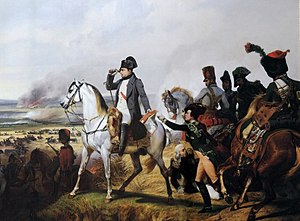Battle of Wagram
| Battle of Wagram | |||||||
|---|---|---|---|---|---|---|---|
| Part of the War of the Fifth Coalition | |||||||
 Napoleon at Wagram, painted by Horace Vernet (Galerie des Batailles, Versailles) |
|||||||
|
|||||||
| Belligerents | |||||||
|
|
|||||||
| Commanders and leaders | |||||||
| Napoleon I | Charles of Austria | ||||||
| Strength | |||||||
| 154,000 or 155,000 |
158,000 or 173,000 (incl. allies) |
||||||
| Casualties and losses | |||||||
| 25,000–37,000 dead, wounded, missing. | 30,000–40,000 dead, wounded or missing. | ||||||
Decisive French victory:
The Battle of Wagram (5–6 July 1809) was a military engagement of the Napoleonic Wars that ended in a decisive victory for Emperor Napoleon I's French and allied army against the Austrian army under the command of Archduke Charles of Austria-Teschen. The battle led to the breakup of the Fifth Coalition, the Austrian and British-led alliance against France.
In 1809, the French military presence in Germany was diminished as Napoleon transferred a number of soldiers to fight in the Peninsular War. As a result, the Austrian Empire saw its chance to recover some of its former sphere of influence and invaded the Kingdom of Bavaria, a French ally. Recovering from his initial surprise, Napoleon beat the Austrian forces and occupied Vienna at the beginning of May 1809. Despite the string of sharp defeats and the loss of the empire's capital, Archduke Charles salvaged an army, with which he retreated north of the Danube. This allowed the Austrians to continue the war but, towards the end of May, Napoleon resumed the offensive, suffering a defeat at the Battle of Aspern-Essling.
It took Napoleon six weeks to prepare his next offensive, for which he amassed a 165,000-man French, German and Italian army in the vicinity of Vienna. The Battle of Wagram began after Napoleon crossed the Danube with the bulk of these forces during the night of 4 July and attacked the 145,000-man strong Austrian army. Having successfully crossed the river, Napoleon attempted an early breakthrough and launched a series of evening attacks against the Austrian army. The Austrians were thinly spread in a wide semicircle, but held a naturally strong position. After the attackers enjoyed some initial success, the defenders regained the upper hand and the attacks failed. Bolstered by his success, the next day at dawn Archduke Charles launched a series of attacks along the entire battle line, seeking to take the opposing army in a double envelopment. The offensive failed against the French right but nearly broke Napoleon's left. However, the Emperor countered by launching a cavalry charge, which temporarily halted the Austrian advance. He then redeployed IV Corps to stabilise his left, while setting up a grand battery, which pounded the Austrian right and centre. The tide of battle turned and the Emperor launched an offensive along the entire line, while Maréchal Louis-Nicolas Davout drove an offensive, which turned the Austrian left, and rendered Charles's position untenable. Towards mid-afternoon on 6 July, Charles admitted defeat and led a retreat, frustrating enemy attempts to pursue. After the battle, Charles remained in command of a cohesive force and decided to retreat to Bohemia. However, the Grande Armée eventually caught up with him and scored a victory at the Battle of Znaim. With the battle still raging, Charles decided to ask for an armistice, effectively ending the war.
...
Wikipedia
